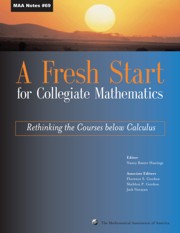Book contents
- Frontmatter
- Preface
- Contents
- Introduction
- Background
- Theme 1 New Visions for Introductory Collegiate Mathematics
- Theme 2 The Transition from High School to College
- Theme 3 The Needs of Other Disciplines
- Theme 4 Student Learning and Research
- Theme 5 Implementation
- Theme 6 Influencing the Mathematics Community
- Ideas and Projects that Work: Part 1
- Ideas and Projects that Work: Part 2
- 35 Mathematics in Action: Empowering Students with Introductory and Intermediate College Mathematics
- 36 Precalculus: Concepts in Context
- 37 Rethinking College Algebra
- 38 From The Bottom Up
- 39 The Functioning in the Real World Project
- 40 The Importance of a Story Line: Functions as Models of Change
- 41 Using a Guided-Inquiry Approach to Enhance Student Learning in Precalculus
- 42 Maricopa Mathematics
- 43 College Algebra/Quantitative Reasoning at the University of Massachusetts, Boston
- 44 Developmental Algebra: The First Mathematics Course for Many College Students
- 45 Workshop Precalculus: Functions, Data, and Models
- 46 Contemporary College Algebra
- 47 Precalculus: A Study of Functions and Their Applications,
- 48 Success and Failures of a Precalculus Reform Project
44 - Developmental Algebra: The First Mathematics Course for Many College Students
from Ideas and Projects that Work: Part 2
- Frontmatter
- Preface
- Contents
- Introduction
- Background
- Theme 1 New Visions for Introductory Collegiate Mathematics
- Theme 2 The Transition from High School to College
- Theme 3 The Needs of Other Disciplines
- Theme 4 Student Learning and Research
- Theme 5 Implementation
- Theme 6 Influencing the Mathematics Community
- Ideas and Projects that Work: Part 1
- Ideas and Projects that Work: Part 2
- 35 Mathematics in Action: Empowering Students with Introductory and Intermediate College Mathematics
- 36 Precalculus: Concepts in Context
- 37 Rethinking College Algebra
- 38 From The Bottom Up
- 39 The Functioning in the Real World Project
- 40 The Importance of a Story Line: Functions as Models of Change
- 41 Using a Guided-Inquiry Approach to Enhance Student Learning in Precalculus
- 42 Maricopa Mathematics
- 43 College Algebra/Quantitative Reasoning at the University of Massachusetts, Boston
- 44 Developmental Algebra: The First Mathematics Course for Many College Students
- 45 Workshop Precalculus: Functions, Data, and Models
- 46 Contemporary College Algebra
- 47 Precalculus: A Study of Functions and Their Applications,
- 48 Success and Failures of a Precalculus Reform Project
Summary
Since 1980, increasing numbers of students are repeating their high school mathematics courses as undergraduates and enrollment in the developmental courses has continued to grow. In Fall 2000, more than three million students were enrolled in undergraduate mathematics courses taught in departments of mathematics. Thirty-one percent of these students (981,000) were enrolled in remedial mathematics courses (arithmetic, algebra I, algebra II). Of these students, 763,000 were at two-year colleges (57% of the total two-year math enrollment) [1].
The large number of students who enroll in remedial courses suggests that the traditional emphasis on showing students how to use a rule to get the answer has failed many students. They learned the rules and passed the course(s) but, despite having learned the rules, they don't know when to apply them. They have not made sense of symbolic notation, nor have they learned to think for themselves. For these students, algebra is nothing but rules applied, often incorrectly, to manipulate symbols, which are meaningless marks on paper [2, 3, 4].
Based on their prior mathematical experience, most students expect to be told which formulas to use, and how to get the correct answers. This narrow approach is where many students stop in their understanding of mathematics—this strict utilitarian perspective too often limits their mathematical vision. Students' descriptions of their prior mathematical experiences and their views of mathematics are remarkably similar:
I was used to having a formula and all I cared about was getting the right answer.
- Type
- Chapter
- Information
- A Fresh Start for Collegiate MathematicsRethinking the Courses below Calculus, pp. 369 - 375Publisher: Mathematical Association of AmericaPrint publication year: 2006



